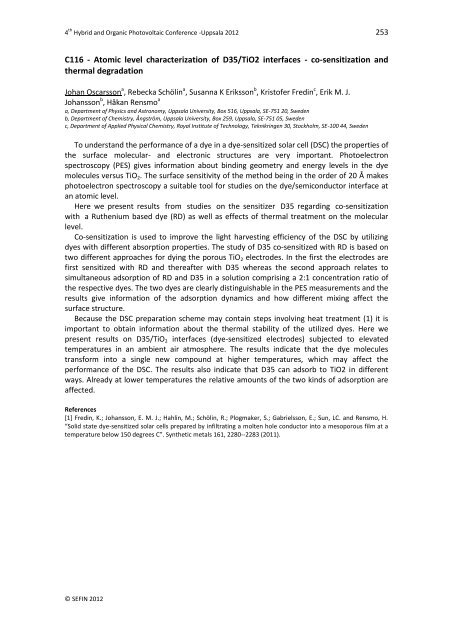HOPV12 - Blogs
HOPV12 - Blogs
HOPV12 - Blogs
Create successful ePaper yourself
Turn your PDF publications into a flip-book with our unique Google optimized e-Paper software.
4 th Hybrid and Organic Photovoltaic Conference -Uppsala 2012 253<br />
C116 - Atomic level characterization of D35/TiO2 interfaces - co-sensitization and<br />
thermal degradation<br />
Johan Oscarsson a , Rebecka Schölin a , Susanna K Eriksson b , Kristofer Fredin c , Erik M. J.<br />
Johansson b , Håkan Rensmo a<br />
a, Department of Physics and Astronomy, Uppsala University, Box 516, Uppsala, SE-751 20, Sweden<br />
b, Department of Chemistry, Ångström, Uppsala University, Box 259, Uppsala, SE-751 05, Sweden<br />
c, Department of Applied Physical Chemistry, Royal Institute of Technology, Teknikringen 30, Stockholm, SE-100 44, Sweden<br />
To understand the performance of a dye in a dye‐sensitized solar cell (DSC) the properties of<br />
the surface molecular- and electronic structures are very important. Photoelectron<br />
spectroscopy (PES) gives information about binding geometry and energy levels in the dye<br />
molecules versus TiO2. The surface sensitivity of the method being in the order of 20 Å makes<br />
photoelectron spectroscopy a suitable tool for studies on the dye/semiconductor interface at<br />
an atomic level.<br />
Here we present results from studies on the sensitizer D35 regarding co-sensitization<br />
with a Ruthenium based dye (RD) as well as effects of thermal treatment on the molecular<br />
level.<br />
Co‐sensitization is used to improve the light harvesting efficiency of the DSC by utilizing<br />
dyes with different absorption properties. The study of D35 co‐sensitized with RD is based on<br />
two different approaches for dying the porous TiO2 electrodes. In the first the electrodes are<br />
first sensitized with RD and thereafter with D35 whereas the second approach relates to<br />
simultaneous adsorption of RD and D35 in a solution comprising a 2:1 concentration ratio of<br />
the respective dyes. The two dyes are clearly distinguishable in the PES measurements and the<br />
results give information of the adsorption dynamics and how different mixing affect the<br />
surface structure.<br />
Because the DSC preparation scheme may contain steps involving heat treatment (1) it is<br />
important to obtain information about the thermal stability of the utilized dyes. Here we<br />
present results on D35/TiO2 interfaces (dye-sensitized electrodes) subjected to elevated<br />
temperatures in an ambient air atmosphere. The results indicate that the dye molecules<br />
transform into a single new compound at higher temperatures, which may affect the<br />
performance of the DSC. The results also indicate that D35 can adsorb to TiO2 in different<br />
ways. Already at lower temperatures the relative amounts of the two kinds of adsorption are<br />
affected.<br />
References<br />
[1] Fredin, K.; Johansson, E. M. J.; Hahlin, M.; Schölin, R.; Plogmaker, S.; Gabrielsson, E.; Sun, LC. and Rensmo, H.<br />
“Solid state dye‐sensitized solar cells prepared by infiltrating a molten hole conductor into a mesoporous film at a<br />
temperature below 150 degrees C”. Synthetic metals 161, 2280-‐2283 (2011).<br />
© SEFIN 2012


